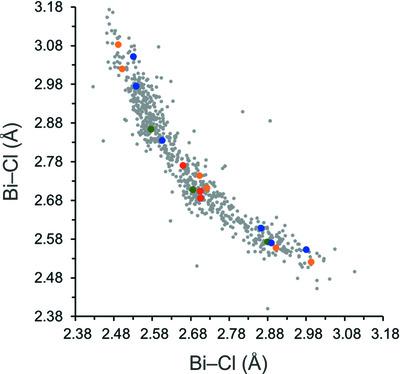当前位置:
X-MOL 学术
›
Acta Cryst. B
›
论文详情
Our official English website, www.x-mol.net, welcomes your feedback! (Note: you will need to create a separate account there.)
Understanding distortions of inorganic substructures in chloridobismuthates(III)
Acta Crystallographica Section B ( IF 2.684 ) Pub Date : 2021-09-21 , DOI: 10.1107/s2052520621004753 Maciej Bujak
Acta Crystallographica Section B ( IF 2.684 ) Pub Date : 2021-09-21 , DOI: 10.1107/s2052520621004753 Maciej Bujak

|
The molar ratio variations of organic and inorganic reactants of chloridobismuthates(III) with N,N-dimethylethane-1,2-diammonium, [(CH3)2NH(CH2)2NH3]2+, and N,N,N′,N′-tetramethylguanidinium, [NH2C{N(CH3)2}2]+, cations lead to the formation of four different products, namely, tris(N,N-dimethylethane-1,2-diammonium) bis[hexachloridobismuthate(III)], [(CH3)2NH(CH2)2NH3]3[BiCl6]2 (1), catena-poly[N,N-dimethylethane-1,2-diammonium [[tetrachloridobismuthate(III)]-μ-chlorido]], {[(CH3)2NH(CH2)2NH3][BiCl5]}n (2), tris(N,N,N′,N′-tetramethylguanidinium) tri-μ-chlorido-bis[trichloridobismuthate(III)], [NH2C{N(CH3)2}2]3[Bi2Cl9] (3), and catena-poly[N,N,N′,N′-tetramethylguanidinium [[dichloridobismuthate(III)]-di-μ-chlorido]], {[NH2C{N(CH3)2}2][BiCl4]}n (4). The hybrid crystals 1–4, containing relatively large but different organic cations, are composed of four distinct anionic substructures. They are built up from isolated [BiCl6]3− octahedra in 1, from face-sharing bioctahedral [Bi2Cl9]3− units in 3, from polymeric corner-sharing {[BiCl5]2−}n chains in 2 and from edge-sharing {[BiCl4]−}n chains in 4. The distortions shown by the single [BiCl6]3− polyhedra in 1–4 are associated with intrinsic interactions within the anionic substructures and the organic…inorganic substructures interactions, namely, N/C—H…Cl hydrogen bonds. The first factor is the stronger, which is evident in comparison of the experimentally determined geometrical and calculated distortion parameters for the isolated octahedron in 1 to the more complex inorganic substructures in 2–4. The formation of N—H…Cl hydrogen bonds, in terms of their number and strength, is favoured for 1 and 3 containing relatively easily accessed hydrogen-bond acceptors of isolated [BiCl6]3− and [Bi2Cl9]3− units. The studies of the deviations from regularity of the [BiCl6]3− octahedra within inorganic substructures were supported by a survey of the Cambridge Structural Database, which confirmed the role played by different factors in the variations in geometry of the inorganic anions.
中文翻译:

了解氯化铋 (III) 中无机亚结构的扭曲
氯化铋(III)与N , N-二甲基乙烷-1,2-二铵、[(CH 3 ) 2 NH(CH 2 ) 2 NH 3 ] 2+和N , N的有机和无机反应物的摩尔比变化,N ', N '-四甲基胍, [NH 2 C{N(CH 3 ) 2 } 2 ] + , 阳离子导致形成四种不同的产物, 即 tris( N , N-二甲基乙烷-1,2-二铵)双[六氯化铋(III)], [(CH 3 ) 2 NH(CH 2 ) 2 NH 3 ] 3 [BiCl 6 ] 2 ( 1 ),链状-poly[ N , N -二甲基乙烷-1,2-二铵[[四氯化铋(III)]-μ-氯化物]], {[(CH 3 ) 2 NH(CH 2 ) 2 NH 3 ][BiCl 5 ]} n ( 2 ), tris( N , N , N ',N '-四甲基胍) 三-μ-氯-双[三氯化铋(III)], [NH 2 C{N(CH 3 ) 2 } 2 ] 3 [Bi 2 Cl 9 ] ( 3 ), and catena -poly[ N , N , N ', N '-四甲基胍 [[dichloridobismuthate(III)]-di-μ-chlorido]], {[NH 2 C{N(CH 3 ) 2 } 2 ][BiCl 4 ]} n ( 4 ) . 混合晶体1 – 4含有相对较大但不同的有机阳离子,由四种不同的阴离子亚结构组成。它们是由孤立的 [BiCl 6 ] 3−八面体在1 中,从面共享生物八面体[Bi 2 Cl 9 ] 3−单元在3 中,从聚合角共享 {[BiCl 5 ] 2− } n链在2和来自边缘共享 {[BiCl 4 ] − } n链 in 4。1 中单个 [BiCl 6 ] 3−多面体显示的变形– 4与阴离子亚结构内的内在相互作用和有机…无机亚结构相互作用有关,即 N/C-H…Cl 氢键。第一个因素是越强,这在用于分离的八面体的实验确定的几何和计算的失真参数的比较可以明显看出1到更复杂的亚结构无机2 - 4。就其数量和强度而言,NH…Cl 氢键的形成有利于1和3包含相对容易获得的孤立 [BiCl 6 ] 3-和 [Bi 2 Cl 9氢键受体] 3−单位。对 [BiCl 6 ] 3-八面体在无机亚结构中的规律性偏差的研究得到了剑桥结构数据库调查的支持,该调查证实了不同因素在无机阴离子几何形状变化中的作用。
更新日期:2021-10-06
中文翻译:

了解氯化铋 (III) 中无机亚结构的扭曲
氯化铋(III)与N , N-二甲基乙烷-1,2-二铵、[(CH 3 ) 2 NH(CH 2 ) 2 NH 3 ] 2+和N , N的有机和无机反应物的摩尔比变化,N ', N '-四甲基胍, [NH 2 C{N(CH 3 ) 2 } 2 ] + , 阳离子导致形成四种不同的产物, 即 tris( N , N-二甲基乙烷-1,2-二铵)双[六氯化铋(III)], [(CH 3 ) 2 NH(CH 2 ) 2 NH 3 ] 3 [BiCl 6 ] 2 ( 1 ),链状-poly[ N , N -二甲基乙烷-1,2-二铵[[四氯化铋(III)]-μ-氯化物]], {[(CH 3 ) 2 NH(CH 2 ) 2 NH 3 ][BiCl 5 ]} n ( 2 ), tris( N , N , N ',N '-四甲基胍) 三-μ-氯-双[三氯化铋(III)], [NH 2 C{N(CH 3 ) 2 } 2 ] 3 [Bi 2 Cl 9 ] ( 3 ), and catena -poly[ N , N , N ', N '-四甲基胍 [[dichloridobismuthate(III)]-di-μ-chlorido]], {[NH 2 C{N(CH 3 ) 2 } 2 ][BiCl 4 ]} n ( 4 ) . 混合晶体1 – 4含有相对较大但不同的有机阳离子,由四种不同的阴离子亚结构组成。它们是由孤立的 [BiCl 6 ] 3−八面体在1 中,从面共享生物八面体[Bi 2 Cl 9 ] 3−单元在3 中,从聚合角共享 {[BiCl 5 ] 2− } n链在2和来自边缘共享 {[BiCl 4 ] − } n链 in 4。1 中单个 [BiCl 6 ] 3−多面体显示的变形– 4与阴离子亚结构内的内在相互作用和有机…无机亚结构相互作用有关,即 N/C-H…Cl 氢键。第一个因素是越强,这在用于分离的八面体的实验确定的几何和计算的失真参数的比较可以明显看出1到更复杂的亚结构无机2 - 4。就其数量和强度而言,NH…Cl 氢键的形成有利于1和3包含相对容易获得的孤立 [BiCl 6 ] 3-和 [Bi 2 Cl 9氢键受体] 3−单位。对 [BiCl 6 ] 3-八面体在无机亚结构中的规律性偏差的研究得到了剑桥结构数据库调查的支持,该调查证实了不同因素在无机阴离子几何形状变化中的作用。


























 京公网安备 11010802027423号
京公网安备 11010802027423号